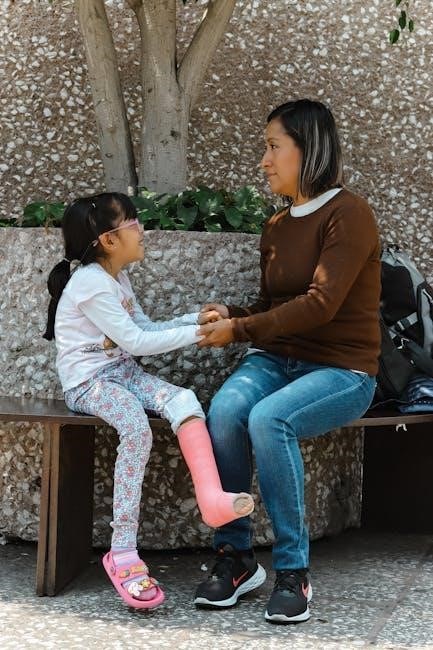The topic explores the emotional impact of unloving mothers on daughters, offering insights and guidance for healing․ It addresses the pain and provides strategies for overcoming childhood wounds, fostering self-compassion, and rebuilding relationships․
1․1 Understanding the Impact of Unloving Mothers on Daughters
The emotional absence or lack of affection from a mother can leave daughters with profound emotional and psychological scars․ Books like Mothers Who Can’t Love by Susan Forward and The Emotionally Absent Mother highlight how such experiences shape a daughter’s self-perception and relationships․ The pain often stems from unmet emotional needs, leading to struggles with self-esteem, trust, and intimacy․ Understanding this impact is crucial for acknowledging the depth of the wound and beginning the healing process․ It’s about recognizing how these early dynamics influence adult behaviors and relationships, providing a foundation for transformation and growth․
1․2 The Importance of Healing and Moving Forward
Healing from the wounds of an unloving mother is essential for breaking cycles of pain and fostering personal growth․ It allows daughters to address unresolved emotions, challenge negative beliefs, and develop self-compassion․ Moving forward involves acknowledging the past while embracing the possibility of transformation․ This process empowers individuals to release resentment and rebuild their sense of self-worth․ By prioritizing healing, daughters can create healthier relationships and find emotional freedom․ It’s a journey that requires courage, self-awareness, and a commitment to reclaiming one’s life, ultimately leading to a more authentic and fulfilling future․

Understanding the Causes of Emotional Distance
Emotional distance often stems from unresolved trauma, societal expectations, and the mother’s own upbringing, which can create barriers to expressing love and fostering a nurturing relationship․
2․1 Exploring the Mother’s Own Upbringing and Trauma
A mother’s inability to love often roots in her own traumatic upbringing, where she may have experienced neglect, abuse, or emotional absence․ Unresolved pain can create emotional unavailability, making it difficult for her to connect with her daughter․ This intergenerational cycle of hurt often goes unrecognized, leaving daughters feeling unworthy or unloved․ Understanding this context helps daughters see that their mother’s behavior is not their fault but a reflection of unresolved wounds․
By examining the mother’s history, daughters can begin to separate their own worth from their mother’s limitations․ This insight fosters compassion and clarity, aiding in the healing process․ Recognizing these patterns is the first step toward breaking the cycle of emotional distance and pain․
2․2 The Role of Societal and Cultural Expectations
Societal and cultural expectations often dictate how mothers should behave, creating pressure to be perfect caregivers․ These norms can suppress a mother’s ability to express vulnerability or seek help, perpetuating emotional distance․ Gender roles may also limit a mother’s emotional expression, fostering a cycle of unavailability․ Cultural demands for strength or self-sacrifice can prevent mothers from addressing their own wounds, leaving daughters feeling unheard and unloved․ Understanding these broader influences helps daughters recognize that their mother’s inability to love is not solely personal but shaped by external pressures․
These expectations perpetuate cycles of emotional suppression, contributing to the challenge of healing and connection․

Recognizing the Effects on Daughters
Daughters of unloving mothers often experience emotional scars, struggles with self-esteem, and challenges in forming healthy relationships․ These effects can deeply impact their sense of worth and identity․
3․1 Emotional and Psychological Scars
Daughters of unloving mothers often bear deep emotional and psychological scars, stemming from feelings of rejection and inadequacy․ These wounds can lead to struggles with self-worth, difficulty trusting others, and challenges in forming healthy relationships․ The absence of maternal affection may result in internalized shame, anxiety, or depression, shaping a fragile sense of identity․ Acknowledging these scars is the first step toward healing, as it allows daughters to understand that their pain is valid and not a reflection of their worth․ This recognition paves the way for rebuilding self-compassion and addressing the long-term effects of insufficient mothering;
3․2 Patterns in Relationships and Self-Esteem
Daughters of unloving mothers often experience challenges in relationships, seeking validation from partners due to unmet childhood needs․ This can lead to attraction to emotionally unavailable individuals or difficulty in setting boundaries․ Low self-esteem may result from internalized messages of inadequacy, impacting confidence and decision-making․ These patterns can perpetuate cycles of self-doubt and dissatisfaction․ Recognizing these dynamics is crucial for breaking free from harmful relationship templates and fostering healthier connections․ Healing involves reclaiming self-worth and developing a compassionate relationship with oneself, allowing for more authentic and fulfilling relationships in the future․

Breaking the Cycle of Pain
Acknowledging the hurt and taking responsibility are vital steps in healing․ This section introduces strategies to confront emotional wounds and begin the journey toward liberation from past pain․
4․1 Acknowledging the Hurt and Taking Responsibility
Acknowledging the emotional pain caused by an unloving mother is the first step toward healing․ Recognizing the impact of her actions without blame is crucial․ Understanding that the hurt was not your fault helps shift perspective․ Taking responsibility for your healing journey empowers you to move forward․ This process involves self-compassion and acceptance, allowing you to confront the past honestly․ Techniques like journaling or therapy can aid in processing these emotions․ By acknowledging the hurt, you create space for growth and liberation from the cycle of pain․ This step is foundational for rebuilding your sense of self and finding peace․
4․2 Mourning the Mother You Needed
Mourning the mother you needed is a profound step in healing․ It involves acknowledging the loss of the nurturing, supportive figure you deserved․ This process allows you to grieve the absence of a loving relationship, validating your feelings of deprivation․ It’s not about blaming your mother but recognizing the emotional gap․ By letting go of the idealized mother, you create space to heal and move forward․ Mourning is essential for releasing unresolved pain and embracing the possibility of a healthier, more compassionate relationship with yourself and others․ This step is crucial for breaking free from the cycle of emotional wounds․

Practical Steps for Healing
Practical steps include therapy, self-compassion, and support systems to heal emotional wounds, fostering resilience, healthier relationships, and personal growth․
5․1 Techniques for Overcoming Childhood Wounds
Techniques for healing include therapy, journaling, and support groups to process emotions and rebuild self-worth․ Setting boundaries with toxic relationships and practicing self-care can foster emotional resilience․ Mindfulness and self-compassion help manage stress and negative thoughts․ Recognizing patterns from childhood wounds allows for personal growth and healthier relationships․ Professional guidance, such as counseling, provides tailored strategies to address deep-seated pain․ These methods empower daughters to release unresolved trauma, embracing a journey toward healing and self-discovery․ By addressing these wounds, individuals can cultivate a stronger sense of identity and move forward with confidence and emotional well-being․
5․2 Building Self-Compassion and Self-Worth
Building self-compassion involves acknowledging your worth and practicing kindness toward yourself․ Journaling and affirmations can help reframe negative beliefs instilled by an unloving mother․ Therapy provides a safe space to explore and heal emotional wounds․ By setting healthy boundaries and prioritizing self-care, you foster resilience and confidence․ Recognizing your strengths and accomplishments reinforces self-worth․ Embracing your individuality and celebrating personal growth are key to overcoming feelings of inadequacy․ Self-compassion becomes a powerful tool for healing, allowing you to develop a positive self-image and move forward with emotional freedom and empowerment․

The Power of Support Systems
Support systems, including therapy and support groups, provide a safe space to share experiences and heal․ They offer guidance, validation, and community, aiding in emotional recovery and growth․
6․1 The Role of Therapy and Counseling
Therapy and counseling provide a safe, guided environment to explore and heal from the emotional wounds caused by unloving mothers․ Trained therapists help daughters understand the root causes of their pain, offering tools to process grief and rebuild self-worth․ Through personalized sessions, individuals can address specific challenges and develop healthier relationship patterns․ Counseling also fosters self-awareness, empowering daughters to break free from harmful cycles and embrace a more compassionate, fulfilling life․ Professional guidance ensures a structured path toward healing, making therapy an essential component in the journey toward emotional recovery and growth․
6․2 Finding Comfort in Support Groups
Support groups offer a nurturing environment where daughters of unloving mothers can share their experiences and connect with others facing similar challenges․ These groups provide validation, reducing feelings of isolation and shame․ Members often find comfort in shared stories and collective understanding, fostering a sense of belonging․ Support groups also serve as a platform for exchanging coping strategies and encouragement, empowering individuals to heal collectively․ Whether in-person or online, these communities play a vital role in the healing journey, reminding daughters they are not alone in their struggles or their path toward recovery and self-discovery․

Forgiveness and Letting Go
Forgiveness is a process, not about forgetting, but releasing negative emotions․ Letting go of resentment allows daughters to heal and move toward self-discovery and peace․
7․1 Understanding Forgiveness as a Process
Forgiveness is a journey, not a quick or easy fix․ It involves acknowledging the pain caused by an unloving mother while releasing the burden of resentment․ Forgiveness doesn’t excuse or condone harmful behavior but allows daughters to heal and move forward․ It’s about letting go of negative emotions tied to the past, creating space for personal growth and peace․ Mourning the mother you needed is part of this process, as is understanding that forgiveness is a recurring effort, not a one-time decision․
7․2 Learning to Let Go of Resentment
Letting go of resentment is crucial for healing․ It liberates daughters from the emotional burden of past hurts, allowing them to move forward․ Resentment, if held onto, can hinder personal growth and distort self-perception․ Releasing it doesn’t mean excusing the mother’s behavior but rather freeing oneself from its grip․ This process involves acknowledging the pain while fostering self-compassion and understanding․ By doing so, daughters can reclaim their emotional well-being and focus on building a healthier sense of self, unshackled by lingering anger or bitterness․

Rebuilding Your Sense of Self
Rebuilding your sense of self involves self-discovery, healing, and growth․ It empowers daughters to embrace their identity, fostering resilience and self-awareness, and helps them move beyond past wounds․
8․1 Identifying and Challenging Negative Beliefs
Identifying and challenging negative beliefs is crucial for healing․ Daughters of unloving mothers often internalize feelings of unworthiness or guilt․ These beliefs, rooted in childhood experiences, can shape self-perception and relationships․ Acknowledging these patterns is the first step toward change․ Techniques like self-reflection, journaling, or therapy can help uncover and question harmful narratives․ Challenging these beliefs involves replacing them with positive affirmations and self-compassion․ This process fosters emotional freedom and empowers individuals to redefine their self-worth․ It’s a powerful step in rebuilding a healthier sense of self and moving beyond the limitations imposed by past wounds․
8․2 Embracing Your Strengths and Resilience
Embracing your strengths and resilience is a vital part of healing․ Recognizing your ability to survive and thrive despite challenges fosters self-compassion and empowerment․ Acknowledging your resilience helps you understand your capacity for growth․ Celebrating your strengths, no matter how small, builds confidence and self-worth․ This process allows you to move beyond the limitations of your past and embrace a future filled with potential․ By focusing on your positive attributes and accomplishments, you reclaim your identity and create a foundation for lasting emotional well-being and personal fulfillment․

Navigating Mother-Daughter Dynamics
Understanding the complexities of mother-daughter relationships is essential for healing․ Setting boundaries and accepting your mother as she is fosters emotional balance and personal growth․
9․1 Setting Healthy Boundaries
Setting healthy boundaries with an unloving mother is crucial for emotional protection and well-being․ Boundaries help daughters detach from harmful dynamics, fostering self-respect and personal growth․ By establishing clear limits, individuals can protect their emotional space and reduce feelings of resentment․ This process involves acknowledging what is and isn’t acceptable, allowing for healthier interactions․ Over time, boundaries empower daughters to prioritize their needs without guilt, creating a foundation for healing and balance in the relationship․ This step is vital for breaking the cycle of pain and fostering a more compassionate and independent sense of self․
9․2 Accepting the Mother You Have
Accepting the mother you have involves acknowledging her limitations without blame․ It’s about recognizing the pain she caused but understanding it stems from her own issues․ This acceptance allows daughters to release the need for a different mother, fostering emotional freedom․ It’s not about condoning her behavior but embracing reality to heal․ By letting go of the idealized mother, daughters can move forward, creating a healthier sense of self and relationships․ Acceptance is a step toward breaking the cycle of pain and finding personal peace․

The Role of Professional Guidance
Professional guidance from therapists and counselors plays a crucial role in facilitating healing for daughters of unloving mothers, offering tailored strategies and emotional support․
10․1 How Therapy Can Facilitate Healing
Therapy provides a safe space for daughters of unloving mothers to process unresolved emotions and identify harmful patterns rooted in childhood․ Through techniques like cognitive-behavioral therapy (CBT) and inner child work, therapy helps individuals reframe negative beliefs and develop self-compassion․ Trained therapists offer guidance to navigate complex emotions, such as grief or anger, and provide tools to rebuild self-worth․ By addressing the emotional scars of insufficient mothering, therapy empowers daughters to break free from toxic cycles and create healthier relationships․ It also fosters resilience, allowing them to heal and move forward without needing their mother’s validation․
10․2 The Importance of Professional Support Networks
Professional support networks, including therapists and counselors, play a crucial role in the healing journey of daughters affected by unloving mothers․ These networks provide a structured and non-judgmental environment to explore deep emotional wounds․ Therapy offers tools to address trauma, reframe negative beliefs, and develop healthy coping mechanisms․ Support groups, whether online or in-person, connect individuals with shared experiences, fostering a sense of community and understanding․ Professional guidance ensures accountability and motivation, helping daughters apply healing techniques in their daily lives․ Such networks are essential for long-term emotional recovery and personal growth․
Healing from an unloving mother’s impact is a journey of self-discovery and empowerment․ Embracing a brighter future involves letting go of pain and fostering healthier relationships․
11․1 Embracing a Brighter Future
Embracing a brighter future begins with healing and self-compassion․ Daughters of unloving mothers can break free from emotional scars by acknowledging their pain and taking steps toward personal growth․ This journey involves mourning the mother they needed and accepting the reality of their relationship․ By releasing resentment and fostering self-worth, they can create a meaningful life filled with healthy relationships and purpose․ Healing is not about forgetting the past but learning from it to build a stronger, more resilient future․
11․2 Empowering Yourself for a Healthier Relationship
Empowering yourself for healthier relationships involves recognizing your worth and setting boundaries․ Healing from an unloving mother-daughter dynamic requires self-awareness and acceptance․ By understanding your emotional needs and learning to meet them, you can cultivate healthier connections․ This empowerment allows you to release toxic patterns and embrace relationships built on mutual respect and trust․ It’s about reclaiming your voice and creating a future where your emotional well-being thrives, fostering positive and nurturing relationships moving forward․

